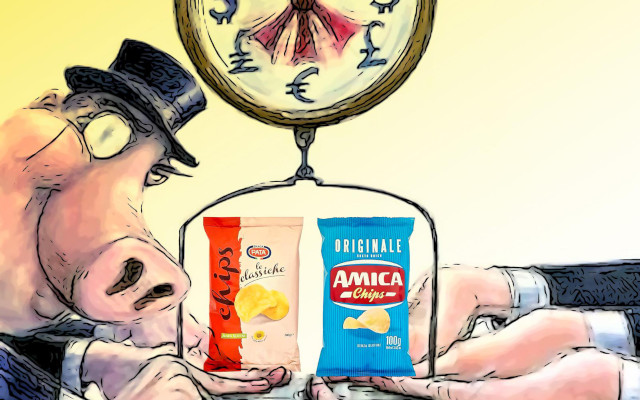Alleged anti-competitive agreement in the market of chips, the French fries in bags. Under the spotlight of the Antitrust ends up a market that moves, in Italy, something like 580 million euros (600 million considering also the tortillas).
The Antitrust Authority has opened an investigation into Amica Chips and Pata for an alleged restrictive agreement on competition relating to the production and marketing of private label crisps produced on behalf of large-scale retail chains.
The two companies would have coordinated their pricing policies, resulting in the division of customers and maintaining prices at a supra-competitive level.
1) Antitrust starts from whistleblowing
The procedure starts from an anonymous report received through the whistleblowing platform on March 1, 2024.
The reporting, explains the Antitrust in the order for the start of the investigation (1), concerns the alleged cartel between Amica Chips and Pata, “consisting in the coordination of price proposals to be presented to buyers of large-scale retail trade” for the sale, at a national level, of the references of the French fries in packets, the private label chips distributed through the large-scale retail trade.
Among the chains involved there would be, writes the Antitrust, Esselunga, Carrefour, Coop, Conad, Lidl, Aldi, MD and Penny.
2) The chips market in Italy
The production of chips in Italy is the prerogative of a rather concentrated market. The Antitrust cites five main producers in its provision: San Carlo Gruppo Alimentare, Pata, Amica Chips, Preziosi Food and Crik Crok.
Friend Chips and Pata would cover a market share of 24% and 29% respectively.
In this market, Private label chips would cover about 10% of the total.
Then there are companies which produce brands of chips in factories in other European countries and import them into Italy: for example Pringles, Lays and Tyrrels, produced respectively by Propter & Gamble, Pepsico and Tyrrells Potato Crisps.
Friend Chips and Pata are the main producers of private label chips in Italy produced for large-scale distribution. In particular, the Antitrust continues, “Amica Chips is a supplier of Esselunga, Lidl, Carrefour, Selex and Crai, while Pata is a supplier of Coop, Pam, Tigre, Conad, Eurospin and Despar“.
Among other producers, “According to the whistleblower, Preziosi Food supplies the chains most present in southern Italy, such as MD and Penny Market, while San Carlo and Crik Crok do not appear to produce crisps for private labels in large-scale retail trade.”.
3) The hypothesized conduct
The Antitrust therefore hypothesizes the existence, at least in 2024, of “a coordination of commercial strategies between the companies Amica Chips and Pata, capable of significantly impacting competition in the relevant market“.
The coordination regard “the coordination of price proposals to be presented to buyers of large-scale retail chains for the sale, at a national level, of private label references of chips distributed at the latter’s points of sale, with the ultimate aim of dividing up the clientele, maintaining prices at a super-competitive level“.
The Antitrust he then explains that the private label market is characterized by a medium-low price, offered by large-scale distribution as an alternative to brands. An agreement on the price therefore ends up reducing its competitive capacity and influencing the entire wholesale market of crisps, “with an inevitable impact on the prices charged to final consumers“.
4) Snacks, the market is still growing
According to an analysis by the Institute Mérieux, after the pandemic, the global market for salty snacks is worth something like 250 and a half billion dollars. It is a growing market even if consumers are increasingly looking for healthy diets. Hence many alternatives, in formulation, ingredients and packaging, developed by the industry.
Customers, In short, they continue to feed on snacks, which are pervasively present on the market (2), despite the health risks associated with the consumption of ultra-processed foods rich in salt and sugar.
According to a recent report of Mondelēz (3), consumers consume snacks “with consistency” and spending on snacks remains unchanged: 66% of consumers say they have not made significant changes to their spending on snacks, despite the growing focus on price.
It’s not comforting in times of price crisis and pandemic of obesity and malnutrition.
Sabrina Bergamini
Footnotes
(1) Competition and Market Authority. Text of the provision https://www.agcm.it/dotcmsdoc/allegati-news/I871_avvio%20istruttoria.pdf
(2) Dario Dongo. Indulgent foods or junk food? The case of French fries. GIFT (Great Italian Food Trade).
(3) State of Snacking https://www.mondelezinternational.com/stateofsnacking/
Journalist. Consumption, rights, nutrition, social, environment. Head of Consumers Help. She collaborated with ResetDOC, Il Riformista, La Nuova Ecologia, IMGPress.








